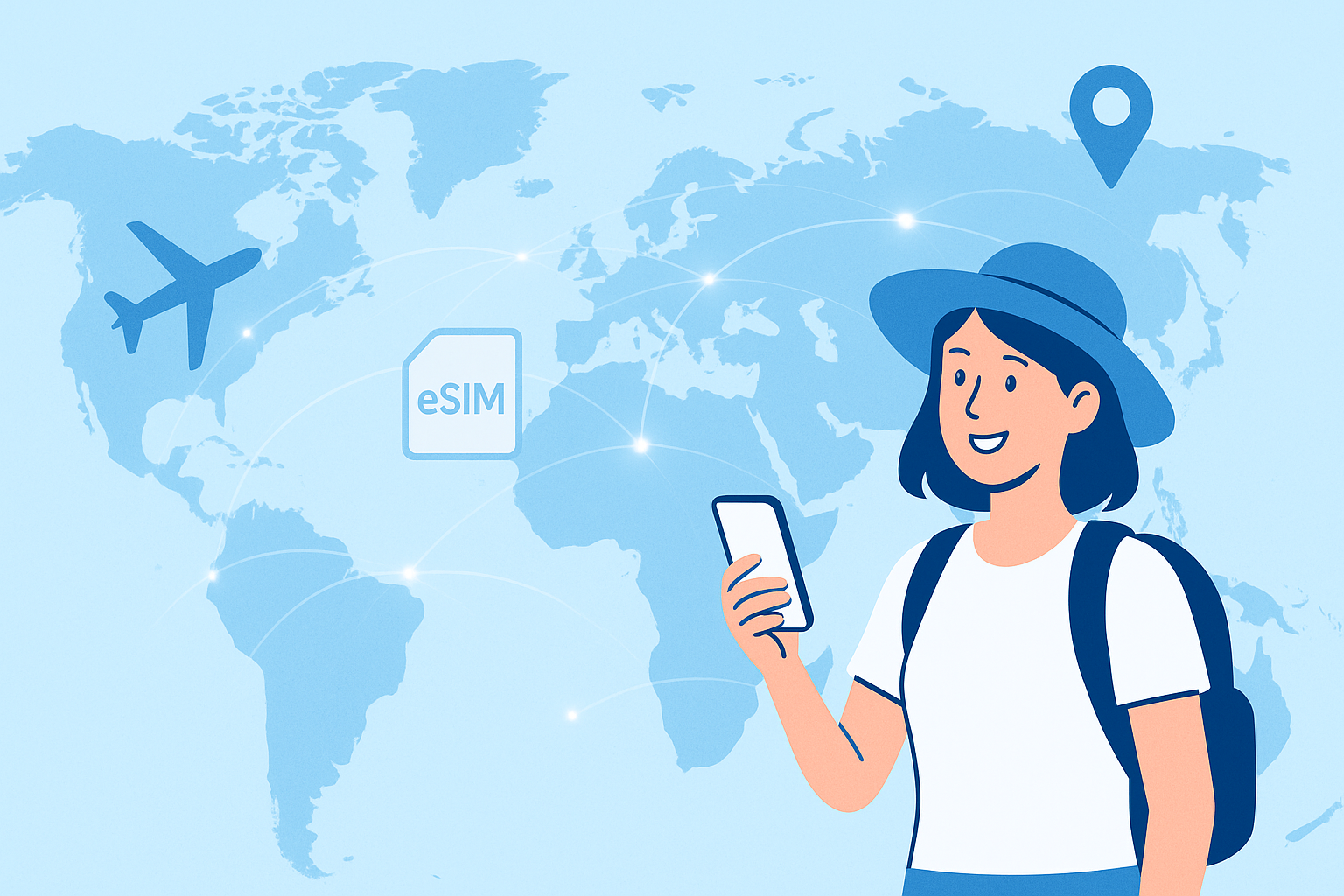Introduction: The SIM Card Struggle Is Real

You just landed at Tokyo’s Haneda Airport after a red-eye flight. You’re groggy, your rideshare app won’t load, and the only thing standing between you and data is a 45-minute queue at a SIM kiosk — if it’s even open. Sound familiar?
This is the exact scenario travelers are ditching in 2025 by switching to eSIMs.
An eSIM (embedded SIM) is a digital version of a traditional SIM card. No need to fumble with plastic trays or hunt for a paperclip. With a few taps, you can connect to a local network before your plane even hits the tarmac.
For international travelers, digital nomads, and tourists alike, the battle of eSIM vs local SIM 2025 is clear: eSIMs are winning — and here’s why.
What Are eSIMs and How Do They Work in 2025?
eSIMs are not new, but 2025 is the year they’ve gone mainstream.
An eSIM is built into your phone and lets you download digital SIM profiles from providers around the world — no physical card required. All major devices now support dual SIM functionality: your primary number stays intact while your eSIM handles international data plans.
You can install multiple eSIM profiles, switch providers mid-trip, or even buy data plans for countries you haven’t entered yet. It’s instant, remote, and paperless.
Why Travelers Still Buy Local SIMs (And Where They Struggle)
Despite the rise of eSIMs, many still buy SIM cards abroad at local kiosks, airports, or convenience stores.
Why?
- Perceived savings (especially for longer stays)
- Need for a local number
- Habit or lack of awareness
But here’s where local SIMs fall short:
- Inconvenience: Finding a shop, showing ID, dealing with language barriers
- Activation delays: Many require manual setup or waiting periods
- Lack of transparency: Vague pricing, hidden charges, or limited data speed
- Physical limitations: Lose the SIM, lose the connection
In 2025, these pain points are avoidable — if you go digital.
10 Real-World Benefits of Travel eSIMs in 2025
Here’s why travel eSIM benefits outpace physical SIMs for 90% of travelers:
| Benefit | Local SIM | eSIM |
|---|---|---|
| Buy before trip | ❌ | ✅ |
| Instant activation | ❌ | ✅ |
| No physical store visit | ❌ | ✅ |
| Keep your original number | ❌ | ✅ (dual SIM) |
| Manage via app | ❌ | ✅ |
| Switch plans easily | ❌ | ✅ |
| No physical damage risk | ❌ | ✅ |
| Multicountry plans | ❌ | ✅ |
| Frequent discounts/coupons | ❌ | ✅ |
| No need for SIM ejector | ❌ | ✅ |
Want the short version? If your phone supports eSIM, there’s almost no reason not to use one.
eSIM vs Local SIM: 2025 Comparison Table

| Feature | Local SIM Card | Travel eSIM |
|---|---|---|
| Activation Time | 30–60 minutes | Under 5 minutes |
| Where to Buy | In-person (airport/shop) | Online (apps/web) |
| Number of Countries Supported | 1 | 1–150+ |
| Setup Complexity | Medium | Easy |
| ID Required | Usually Yes | Usually No |
| Reusability | No | Yes |
| Best For | Long stays, local calls | All trips, data access |
Tip: If your top priority is mobile data for maps, rideshare, and messaging — eSIMs are faster, cheaper, and far easier to manage.
Best Travel Scenarios Where eSIMs Win
Whether you’re hopping between cities or need fast data for work, eSIMs shine in these situations:
- Solo travelers on short trips: No need to waste time finding local providers
- Digital nomads: Use one eSIM plan across multiple countries in Europe or Southeast Asia
- Business travelers: Get instant data for work calls or meetings straight from the airport
- Layover travelers: Buy 1–2 day eSIMs for quick access without commitments
- Families: Install eSIMs on multiple devices and manage usage via one dashboard
Common Misconceptions About eSIMs Debunked
Let’s clear up a few myths holding people back:
“eSIMs don’t work in every country.”
Fact: In 2025, eSIM coverage spans over 190 countries. Check the provider’s coverage map before you buy.
“I need a local number for calls.”
Fact: Most communication happens over apps like WhatsApp, Skype, or Zoom. You can still use these with an eSIM-only plan.
“eSIMs are expensive.”
Fact: Not anymore. With options from Airalo, Nomad, SimOptions, and more, many eSIM plans are cheaper than local SIMs — especially with promo codes.
“They’re hard to set up.”
Fact: If you can scan a QR code, you can set up an eSIM.
How to Switch to an eSIM in Minutes – Step-by-Step
- Check Compatibility:
Visit eSIM compatible phones to check if your device is listed in the list of eSIM-compatible phones - Choose a Provider:
Choose from top platforms that best suit your travel needs. - Buy Your Plan:
Select country, data amount, and duration. - Install via QR or App:
Scan a QR code or follow in-app setup instructions. - Activate and Go:
Switch on mobile data and roam free.
Need help? Use our eSIM setup guides for country-specific walkthroughs.
Final Thoughts: Travel Smarter in 2025
The way we connect abroad has evolved — and the physical SIM card is quickly becoming a relic of the past. In 2025, the eSIM vs local SIM debate isn’t just about convenience; it’s about efficiency, flexibility, and getting the most value out of your travel experience.
Whether you’re a digital nomad hopping between coworking cafes in Lisbon and Chiang Mai, or a first-time tourist navigating Seoul’s metro, eSIMs offer a hassle-free way to stay online without the baggage — literally.
Skip the queues, forget the plastic, and embrace a smarter way to roam. The future of travel connectivity is already here — and it’s digital.
FAQs: Your eSIM Questions Answered
1. Are eSIMs compatible with all phones in 2025?
Most modern smartphones (iPhone XR and up, Pixel 4+, Samsung Galaxy S21+, etc.) support eSIM. Always check your model on the manufacturer’s website.
2. Is it safe to use eSIMs for international travel?
Yes. eSIM profiles are encrypted, and you buy from vetted global providers. No need to hand over your passport or SIM to strangers at a kiosk.
3. Can I still use WhatsApp with an eSIM?
Absolutely. Your WhatsApp stays linked to your original number even when using a data-only eSIM.
4. What if I need a local number in another country?
Some providers offer eSIMs with local numbers. Alternatively, use VoIP apps or add call forwarding from your home number.
5. Can I top up my eSIM or extend it?
Yes. Most providers allow recharging directly via their app or website.






Leave a Reply